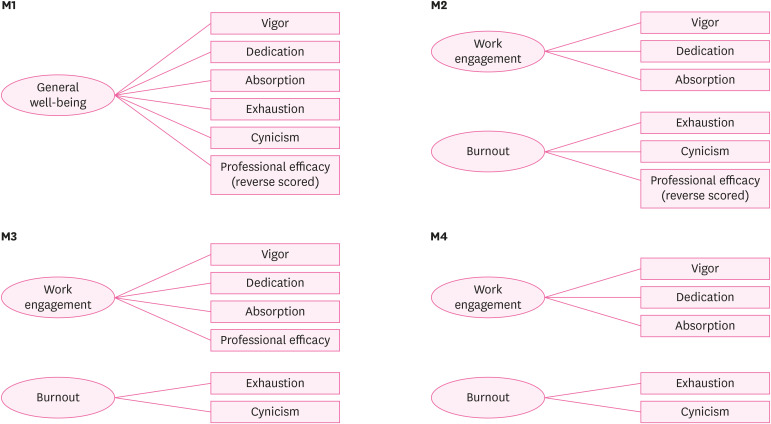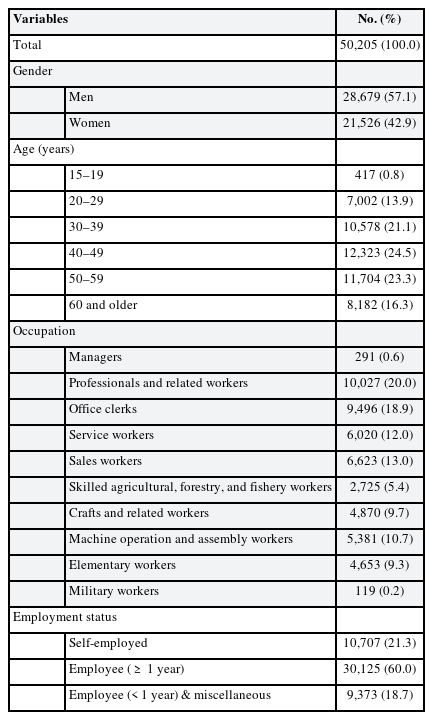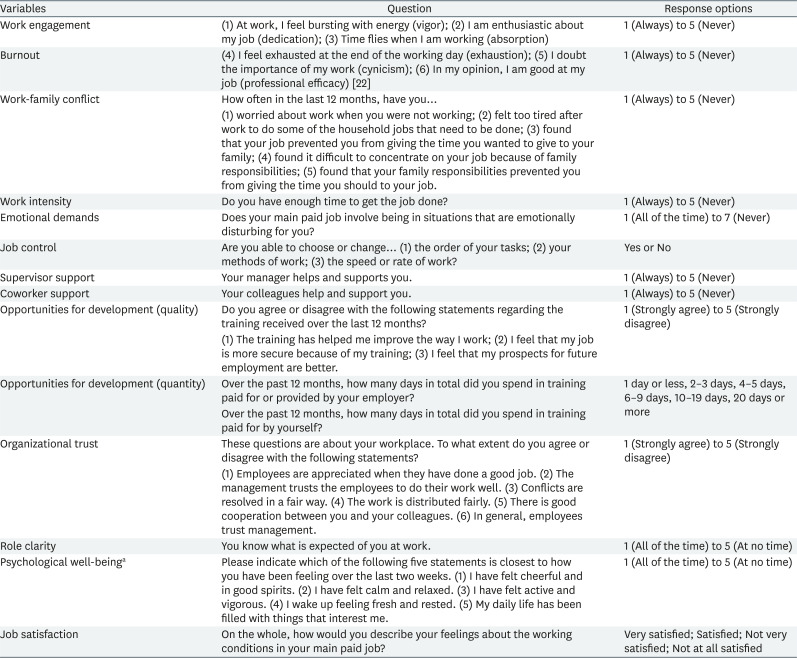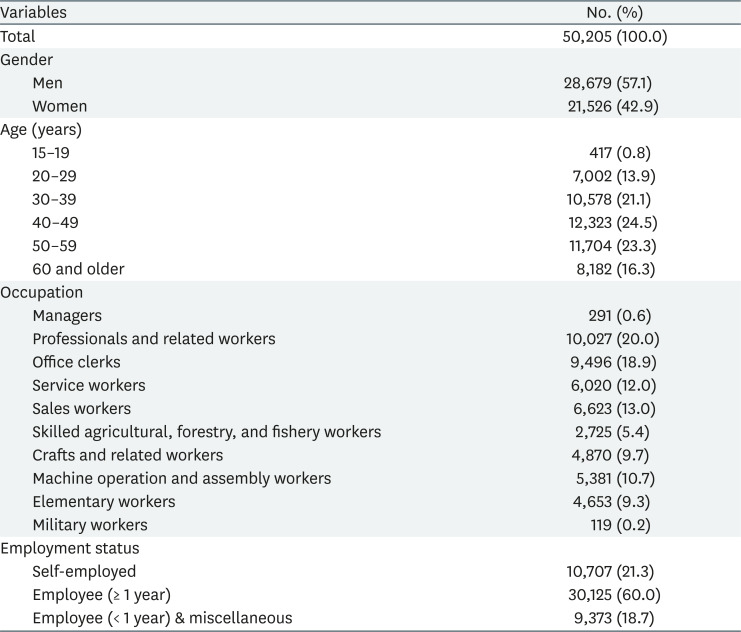Validation of the Work Engagement Scale-3, used in the 5th Korean Working Conditions Survey
Article information
Abstract
Background
The purpose of this study was to assess the reliability and validity of the 3-item version of the Work Engagement Scale (WES-3), which is based on the Job Demands-Resources (JD-R) model and was used in the 5th Korean Working Conditions Survey (KWCS).
Methods
This study used data from the 5th KWCS (n = 50,205), which was conducted in 2017 with a sample of the Korean working population. The survey gathered comprehensive information on working conditions to define workforce changes and the quality of work and life. The reliability and internal consistency of the WES-3 were assessed using the corrected item-total correlation and Cronbach's alpha coefficient. Confirmatory factor analysis (CFA) was used to test the construct validity of work engagement. The convergent validity was assessed using the correlation with the WHO-5 well-being index. Correlations between work engagement and JD-R factors were also calculated.
Results
The Cronbach's alpha for work engagement was 0.776, indicating acceptable internal consistency. The model comprising 3 work engagement and 2 burnout items showed an excellent fit (χ2: 382.05, Tucker-Lewis index: 0.984, comparative fit index: 0.994, root mean square error of approximation: 0.043). The convergent validity was significant (correlation coefficient: 0.42). Correlations with burnout and job demands were negligible, whereas correlations with job resources and job satisfaction were weakly positive.
Conclusions
The results of our study confirm that the WES-3 has acceptable reliability and validity.
BACKGROUND
Work engagement or employee engagement is an emerging concept in the area of employee well-being. Engagement was first conceptualized by Kahn as the “harnessing of organizational members' selves to their work roles; in engagement, people employ and express themselves physically, cognitively, and emotionally during role performances” [1]. A few years later, Maslach and Goldberg [2] proposed engagement as the antipode to burnout, i.e., a goal worth achieving to prevent workers from burnout.
With the rise of positive psychology [3], scholars' interest in engagement changed from viewing it as a tool for the prevention of burnout to recognizing the positive aspects of engagement itself. Simply put, burnout results in negative performance [4], whereas engaged people show positive performance in their work. Several studies have shown that engaged employees perform better, are more productive, and have higher levels of job satisfaction [5678]; furthermore, this effect increases over time [9]. Thus, questions about the level of workers' engagement and how that engagement could be fostered became important.
The Job Demands-Resources (JD-R) model is considered to provide the best description of the factors contributing to work engagement and burnout. Job demands are defined as “aspects of the job that require sustained physical or mental effort” [10]. Work intensity and work-life conflicts are examples of job demands. Job demands, which are the most important predictors of burnout [11], are negatively related to work engagement. However, for those who are optimistic, job demands can be taken as a challenge and may therefore be positively related to work engagement [12]. Resources are defined as “aspects of the job that may do any of the following: i) be functional in achieving work goals; ii) reduce job demands and the associated physiological and psychological costs; and iii) stimulate personal growth and development” [10]. Coworker support, supervisor support, and organizational trust are examples of job resources. Job resources are the most important antecedents of work engagement, and they also protect workers from burnout by buffering the effects of high job demands [12].
Recently, various items measuring work engagement and burnout were added to the 6th Europe Working Conditions Survey (EWCS) and the 5th Korean Working Conditions Survey (KWCS). To measure work engagement, three items from the Utrecht Work Engagement Scale (UWES) were used. The UWES is the most widely used operationalization of work engagement in academic studies [13]. Schaufeli defined work engagement as “a positive, fulfilling, work-related state of mind that is characterized by vigor, dedication, and absorption” [14]. The UWES originally consisted of a 17-item self-report questionnaire covering three dimensions of work engagement. A shorter version with 9 items was later introduced [15] and validated in many countries around the world, including Japan, China, and Brazil [161718]. The UWES has since been shortened to a 3-item version [19], providing a simple measurement tool that can be easily incorporated into a variety of surveys. However, only the 9-item version has been translated into South Korean [20]. The purpose of the present study was to assess the reliability and validity of the 3-item version of the Work Engagement Scale (WES-3), using the items in the 5th KWCS.
METHODS
Data
This study was based on data from the 5th KWCS conducted in 2017 by the Korea Occupational Safety and Health Agency (KOSHA) with a sample of the Korean working population (n = 50,205). The basic sample design was multistage random sampling. Enumeration districts in the 2010 Population and Housing Census were used for sampling. Data were gathered via face-to-face interviews at homes using the questionnaire. The survey gathered comprehensive information on working conditions to define workforce changes and the quality of work and life. The survey targeted the economically active population aged ≥ 15 years who were paid workers or self-employed at the time of the interview [21]. This study used data from the Korean Working Conditions Survey (2017) from the KOSHA. Thus, no separate ethics approval was required.
Measures
The measures are listed in Table 1. The items in the 5th KWCS were translated from the master version of the 6th EWCS.
Data analysis
The reliability and internal consistency of the items were assessed using the corrected item-total correlation and Cronbach's alpha coefficient. For the corrected item–total correlation, a cutoff value of 0.4 for item deletion was used [24]. For the Cronbach's alpha coefficient, a threshold of 0.7 was considered acceptable, a value > 0.8 was considered good, and a value > 0.9 was considered to show excellent internal consistency [25].
Validity
CFA was used to test the construct validity of work engagement. The UWES assessment of work engagement comprises three theoretical constructs and is based on the idea that engagement is the antithesis of burnout. Four sets of models were tested to evaluate the work engagement construct and to determine whether work engagement could be differentiated from burnout (Fig. 1). The first model (M1) assumed that all items were loaded on one general well-being factor. The second model (M2) assumed that three work engagement items represented one factor and three burnout items represented another. The third model (M3) grouped four positive items (three items addressing work engagement and one differentiating professional efficacy from burnout) into one factor and two negative items (exhaustion and cynicism components of burnout) into another. In this case, professional efficacy was not reverse scored. The final model (M4) grouped three work engagement items into one and two negative items regarding burnout into a second factor. For the fit indices, the chi-square test, comparative fit index (CFI), Tucker-Lewis index (TLI), and root mean square error of approximation (RMSEA) were used. Generally, CFI and TLI values ≥ 0.95 and RMSEA ≤ 0.06 are considered acceptable [2627]. Pearson's correlation coefficients between work engagement and the World Health Organization Five Well-Being Index (WHO-5) well-being index were calculated to examine convergent validity. Correlations between work engagement and other JD-R factors were also calculated. Correlations below 0.20 were considered weak, those between 0.2 and 0.30 were considered moderate, and those greater than 0.30 were considered strong [28]. IBM SPSS AMOS ver. 25 software (IBM Corp., New York, NY, USA) was used for analyses.
RESULTS
Characteristics of the study population
Respondents' characteristics are shown in Table 1. The total number of respondents came to 50,205 (male 57%, female 43%). Of these, 69, 106, and 79 people refused to answer or provided unclear responses to the vigor, dedication, and absorption items, respectively. The highest proportion of respondents in terms of age were people in their 40s (24.5%), and professionals were the most frequent respondents in terms of occupational category (20.0%). Sixty percent of respondents were employees who had been employed for more than a year at their current position (Table 2).
Reliability
The corrected item-total correlation was 0.56–0.65; thus, no item was deleted. The Cronbach's alpha for work engagement was 0.776, indicating acceptable internal consistency (Table 3).
Validity
The results of CFA are shown in Table 3. As expected, M1, with one latent well-being factor, was not a good fit for the data. M2, with 2 different well-being factors, i.e., work engagement and burnout, also showed a poor fit. M3, which included four positive items (3 work engagement items and 1 unreversed burnout item) showed an excellent model fit (fit indices: χ2[9]: 633.97, TLI: 0.986, CFI: 0.993, RMSEA: 0.039). M4, which had three work engagement and 2 burnout items, also showed an excellent fit (χ2[4]: 382.05, TLI: 0.984, CFI: 0.994, RMSEA: 0.043) (Table 4). The convergent validity was significant, with correlation coefficients of 0.42 for vigor, 0.37 for dedication, and 0.27 for absorption.
Correlations with JD-R factors
Correlations with other items in the 5th KWCS are shown in Table 5. The correlations with other work engagement items were moderate (0.47 to 0.60), and those with the total score were high (0.80 to 0.85). Correlations for exhaustion and cynicism were negligible (−0.04 to 0.07), and that for reduced professional efficacy was weak to moderate and negative (−0.59 to −0.44). Correlations with job demands were negligible (−0.23 to 0.05), and those with job resources (0.02 to 0.44) and job satisfaction (0.20 to 0.30) were weakly positive (Table 5).
DISCUSSION
The current study is the first to validate the three-item version of the Work Engagement Scale in Korea. The internal consistency was acceptable; Cronbach's alpha was > 0.776, and inter-item and item-total correlations were > 0.40. The construct validity of work engagement was assessed via CFA. The model with three work engagement items and two burnout items showed an excellent fit (χ2[4]: 382.05, TLI: 0.984, CFI: 0.994, RMSEA: 0.043). Convergent validity using the WHO-5 well-being index was significant. These results suggest that the WES-3 is a reliable measure of work engagement in the Korean context.
We assumed that work engagement consists of three dimensions and that it is antithetical to burnout. Among our tested models, M3 and M4 showed excellent fit (Table 4). Vigor and dedication vs. exhaustion and cynicism are considered the core dimensions of work engagement and burnout, and absorption vs. professional inefficacy constitute, to some degree, a consequence of the former dimensions [1129]. Some controversies about the relationships among these dimensions have arisen, e.g., associating professional efficacy with work engagement or with burnout [142930]. Our data from M3 suggested that professional efficacy was associated with work engagement. However, this association may be the result of our using the third item measuring burnout, which is a positive item that asks about professional efficacy. However, it is questionable whether inefficacy can be assessed by simply reversing the score for efficacy [30]. The single item addressing professional efficacy may have been interpreted as referring to self-efficacy in personal resources. Thus, a questionnaire consisting only of negative items may be needed to avoid the reverse-scoring dilemma. M4 also showed an excellent fit, indicating that the 3 work engagement items and two core burnout items represent distinctive components of well-being.
Convergent validity was assessed using Pearson's correlation. Correlations with psychological well-being were moderate to strong, consistent with the findings of a previous study [31]. Correlations with other psychosocial factors at work were also assessed. The expected results were observed in correlations between work engagement and the JD-R model. As described earlier, work demands may lower work engagement; however, in certain personalities, they may increase work engagement. Thus, a negligible or weakly negative correlation was expected. In a study that validated the work engagement scale in 5 separate countries [19], the correlations of work engagement with work overload, emotional demand, and work–home conflict ranged from −0.01 to 0.17, −0.07 to 0.10, and −0.10 to −0.08, respectively. In our study, correlations with emotional demand and work-home conflict were consistent with those in other countries. Work intensity was also negligible, although it differed from work overload. Correlations with job resources were mostly weakly positive, consistent with other studies [19]. Correlations with supervisor support, coworker support, role clarity, and organizational trust were 0.19 to 0.37, 0.11 to 0.30, 0.29 to 0.37, and 0.37 to 0.39, respectively. However, the correlations of job control and opportunity with development were lower than those reported in other studies. Survey items may have differed among countries; observed differences may also have varied according to the culture of the country. Investigations of cross-national invariances of these measures are needed.
Correlations with job satisfaction were also positive, consistent with other studies [3233]. However, the correlation with burnout was unexpected. We anticipated a weakly negative correlation between work engagement and burnout [1620], but our results showed no correlation. The following considerations may explain this result. First, unlike most other studies, our research included a variety of occupations. There are 5 types of burnout questionnaires, which differ among occupational groups. The items used in this study were from the Maslach Burnout Inventory-General Survey (MBI-GS) questionnaire, which is best suited for general use. Nonetheless, it cannot assess burnout of workers in all occupations. This was apparent for certain occupational groups who answered the questionnaire [30]. Second, work engagement and burnout could be independent factors from the beginning. Although work engagement and burnout are conceptual opposites, in reality, work engagement and burnout can coexist in one's mind. For example, an employee can be engaged in task A, while feeling burnout in task B. If employees were asked whether they were feeling engaged or experiencing burnout in their job, they might well say both. These reactions can coexist, and they might be mutually independent. Finally, the translation may have affected the results. KOSHA translated items from the EWCS and then used those items in the KWCS. The translated wording was not identical to the Korean version of UWES [20] and the MBI-GS [34]. The psychological meaning of questionnaire items can be altered during the translation process. Such changes may have lowered the correlation between work engagement and burnout, as compared to findings from other studies.
This study had some limitations. First, the WES-3 was not directly compared with other validated versions of UWES. However, the WES-3 showed good reliability and excellent validity in this study. Further studies comparing WES-3 and the existing UWES-K [20] are needed. Second, the evaluation of convergent and divergent validity based on the JD-R model was limited because the questionnaires in the KWCS were not previously validated. Although we reported the correlation coefficients of those factors (Table 5), the ability of the KWCS to show convergent and divergent validity remains limited. Further studies assessing the validity of the psychosocial factors of work in the KWCS are needed. Finally, the WES-3 differs from the ultra-short version of UWES. For instance, the same items were used for the vigor and dedication dimensions, but not for absorption. “Time flies when I am working” was used in WES-3, whereas “I am immersed in my work” was used in the ultra-short version of UWES. Since this is a developer-selected item, it is likely that the UWES-3 items would be used in subsequent surveys.
Despite these limitations, this study is the first to validate the three-item version of the Work Engagement Survey in South Korea. The nine-item Korean version of UWES [20] was validated in 2017, but in aspects of decreasing respondent burden and increasing response rates due to survey length [35], validation of the WES-3 is very meaningful. We used the survey data from the KWCS, a large sample of more than 50,000 Korean workers that includes all occupational groups. Thus, we can generalize the validation of the WES-3 to Korean workers in general. Because the questionnaire measuring work engagement was included in the national survey, we hope that data on work engagement become more accessible and central to human resources management in Korea.
CONCLUSIONS
In summary, this study confirmed that the WES-3 has acceptable internal consistency, excellent model fit, and significant positive correlation with psychological well-being. Therefore, the WES-3 is an acceptable measure of work engagement in South Korea.
Acknowledgements
We would like to thank the Safety and Health Policy Research Department (Occupational Safety and Health Research Institute; OSHRI) for offering raw data of KWCS. The paper's contents are solely the responsibility of the author and do not necessarily represent the official view of the OSHRI.
Notes
Competing interests: The authors declare that they have no competing interest.
Availability of data and materials: Data of the Korean Working Conditions Survey were provided by the Korea Occupational Safety and Health Agency and are available at http://www.kosha.or.kr/kosha/data/primitiveData.do.
Author Contributions:
Conceptualization: Suh C, Choi M.
Data curation: Choi M.
Formal analysis: Choi M, Choi SP.
Investigation: Choi M, Suh C, Choi SP.
Writing - original draft: Choi M.
Writing - review & editing: Choi M, Suh C, Choi SP, Lee CK, Son BC.
Abbreviations
CFA
confirmatory factor analysis
CFI
comparative fit index
EWCS
European Working Conditions Survey
JD-R
Job Demands-Resources
KOSHA
Korea Occupational Safety and Health Agency
KWCS
Korean Working Conditions Survey
MBI-GS
Maslach Burnout Inventory-General Survey
OSHRI
Occupational Safety and Health Research Institute
RMSEA
Root Mean Square Error of Approximation
TLI
Tucker-Lewis Index
UWES
Utrecht Work Engagement Scale
WES-3
Work Engagement Scale-3
WHO-5
World Health Organization Five Well-Being Index











